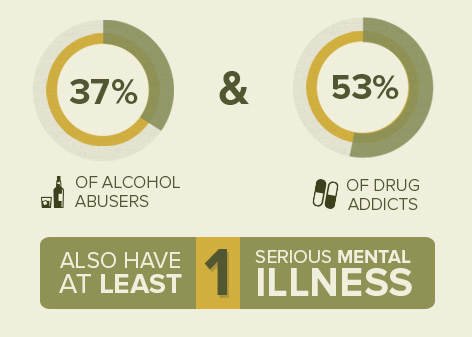Dual diagnosis, also known as co-occurring disorder, is exactly what it sounds like. It is when a person is diagnosed with a drug or alcohol problem and one or more mental illness(es). The problem is more common than most realize.
- According to the National Alliance on Mental Illness, 50 percent of those who are mentally ill also have a substance abuse problem.
- Mentally ill males are particularly susceptible to substance abuse, as are people who are ages 18 to 44.
- 37 percent of those who abuse alcohol and 53 percent of individuals struggling with drug addiction also have at least one serious mental illness, according to the Journal of the American Medical Association.
- The most common mental-health disorders found in dual-diagnosed individuals are anxiety, depression, and bipolar disorder.
Warning Signs That You Might Be Suffering From Dual Diagnosis
The warning signs of dual diagnosis vary. Since there are many different types of drugs and mental disorders, there is not one definitive list, though there are some common problems people with dual diagnosis may share. You may have dual diagnosis if: 1. Even before your addiction you exhibited signs of anxiety, depression, or bipolar disorder. 2. It is hard to stop your addiction because your anxiety, depression, or any other form of a mental issue grows worse without drugs or alcohol. 3. You find yourself with a new crowd of friends or alienating people altogether. 4. There are periods of extreme emotional highs and then extreme depression. 5. You feel out of control, so you use alcohol or drugs to feel better. 6. You have tried to quit drinking, smoking, or taking drugs, but you have found that you can’t. 7. You have trouble concentrating and often have panic attacks. 8. When trying to quit, you find yourself frequently depressed. 9. A history of addiction or mental illness runs in your family. 10. You often exhibit erratic behavior, irritability, or insomnia.
How to Tell if a Friend or Family Member Has Co-Occurring Disorders
Many of the symptoms of addiction are also the same as mental illness, so it can be hard to pinpoint whether a loved one is simply suffering from the effects of addiction or if they have a deeper mental illness. If you already know your loved one or friend is diagnosed with mental illness, look for these signs to see if there is also a substance abuse problem.
- Dilated pupils or pinpointed eyes
- Valuables seem to vanish or lack of money
- Erratic behavior
- Lack of personal hygiene
- Alienating friends and family
- Needles, lighters, medicine bottles, and other drug paraphernalia in the house
- Long periods of time in the bathroom
- Needle marks or unusual bruising
There are also signs that family and friends can look for if someone they love is suffering from mental illness.
- A family history of mental illness
- Depression symptoms such as hopelessness, despair, or worthlessness
- Delusions or hallucinations
- The compulsive need to do things a certain way to relieve anxiety
- Mood swings that prevent normal standards of living
- Dramatic changes in energy levels or moods
- Reckless behavior and anger
What to Do if You Suspect Co-occurring Disorder
If you suspect a friend or relative may have an undiagnosed mental-health disorder or they may be using drugs or alcohol, it is important to avoid making the person feel like you are ganging up on them. There are some ways to help without making the situation worse.
Diagnosis
Co-occurring disorder is often misdiagnosed because the drugs or alcohol can cause symptoms that appear to be psychiatric, but are simply repercussions from addiction or usage. For example, individuals struggling with addiction often suffer from depression or paranoia. While these are psychiatric problems, often these issues are related to their addiction and not their mental illness. Usually, an individual who is suspected of dual diagnosis will need to become sober for a certain amount of time to allow doctors to determine if the symptoms are caused by drugs or alcohol. A mental health professional will need to diagnose a mental illness using guidelines provided by the American Psychiatric Association. To get help, a person potentially suffering from co-occurring disorder can contact a local physician, psychiatrist, counselor, psychologist, or therapist for a diagnosis.
Treatment
Drug or alcohol use can worsen mental health, just as poor mental health can worsen an addiction. People with dual diagnosis are at a disadvantage, because substance-abuse treatment does not often encompass mental illness. Similarly, most mental health treatment facilities do not deal with substance abuse. However, there are dual diagnosis rehab centers that deal with both disorders, so it is important for an individual to seek out a co-occurring disorder treatment program for the best care. Since there are so many types of addiction and mental illness, there are also many different types of dual-diagnosis treatment. Treatment will also depend on the severity of the addiction. Treatment often comes in three steps:
- The client is evaluated to find the problem and to determine the best treatment options. Those with severe addiction or mental problems may need to be admitted to an inpatient facility, while those with less severe conditions may do well with outpatient treatment.
- Once a plan has been made, the client will undergo a detoxification. This means removing the drugs or alcohol from the individual’s system and dealing with withdrawal. Typically, detox must occur before an individual can get further treatment. Clients may be given prescriptions to help with mood swings, hallucinations, anxiety, and other symptoms of the mental illness, as well as withdrawal symptoms.
- Rehabilitation is the next step in co-occurring disorder treatment. The client will participate in Group and Individual Therapy, Family Therapy, or other therapy techniques that work with the client’s situation.
Treatment is continuous and never fully ends — clients will continue to receive care even after they are discharged from a facility, including support meetings, doctor visits, and therapy sessions. While treatment can be more difficult for someone with a co-occurring disorder, rehabilitation is more than possible. Note: The pictures in this content are being used for illustrative purposes only; and any person depicted in the content, if any, is a model.

